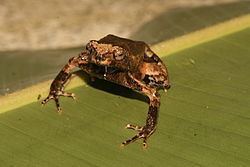Phylum Chordata Order Frog | Rank Genus | |
 | ||
Similar Frog, Túngara frog, Edalorhina, Rhaebo, Strabomantis | ||
Engystomops pustulosus y su nido de espuma
Engystomops is a genus of frogs in the family Leptodactylidae. They are known commonly as foam frogs or túngara frogs, though the latter name most commonly refers to Engystomops pustulosus. They are native to the Americas from Mexico south to the Amazon Basin.
Contents
- Engystomops pustulosus y su nido de espuma
- Engystomops pustulosus chorus t ngara frog
- Description
- Species
- References
This genus was maintained on its own until 1970, when it was merged into Physalaemus, a genus of similar frogs. As studies progressed, there was increasing evidence that Physalaemus was not a monophyletic group; it was made up of several groups. One of those groups consisted of several frogs more closely related to each other than to the rest of the Physalaemus, and they were represented by P. pustulosus, now Engystomops pustulosus. This group was split off in 2005 on the basis of characters such as basic morphology and vocalizations, as well as allozyme and other genetic analysis. The group was given the revalidated name Engystomops. It included two newly described species.
Engystomops pustulosus chorus t ngara frog
Description
These frogs measure about 1.5 or 1.6 to 3.5 or 3.8 centimeters long.
These frogs live on the forest floor. They breed in temporary pools, sometimes in puddles that form during the rainy season. They are perhaps best known for their foam-nest-building behavior, particularly E. pustulosus, in which the behavior has been well-studied. During mating, the male releases sperm while the female releases eggs and a protein-rich fluid. The male vigorously beats the fluid into a foam with his feet. The eggs are suspended in the foam, which acts as a protective matrix. Some of the proteins have surfactant properties, keeping the foam mass stable on the water, while others likely have antimicrobial and antiparasite properties.
Frogs of this genus have been researched in studies of sexual selection and communication in animals.
Species
As of 2006, there were about 10 or 11 species in the genus, including species yet undescribed. It has been suggested that E. pustulosus is a cryptic species complex, and E. petersi may be, as well. Another species received a formal description in 2010.
As of early 2014, there are nine species in this genus:
